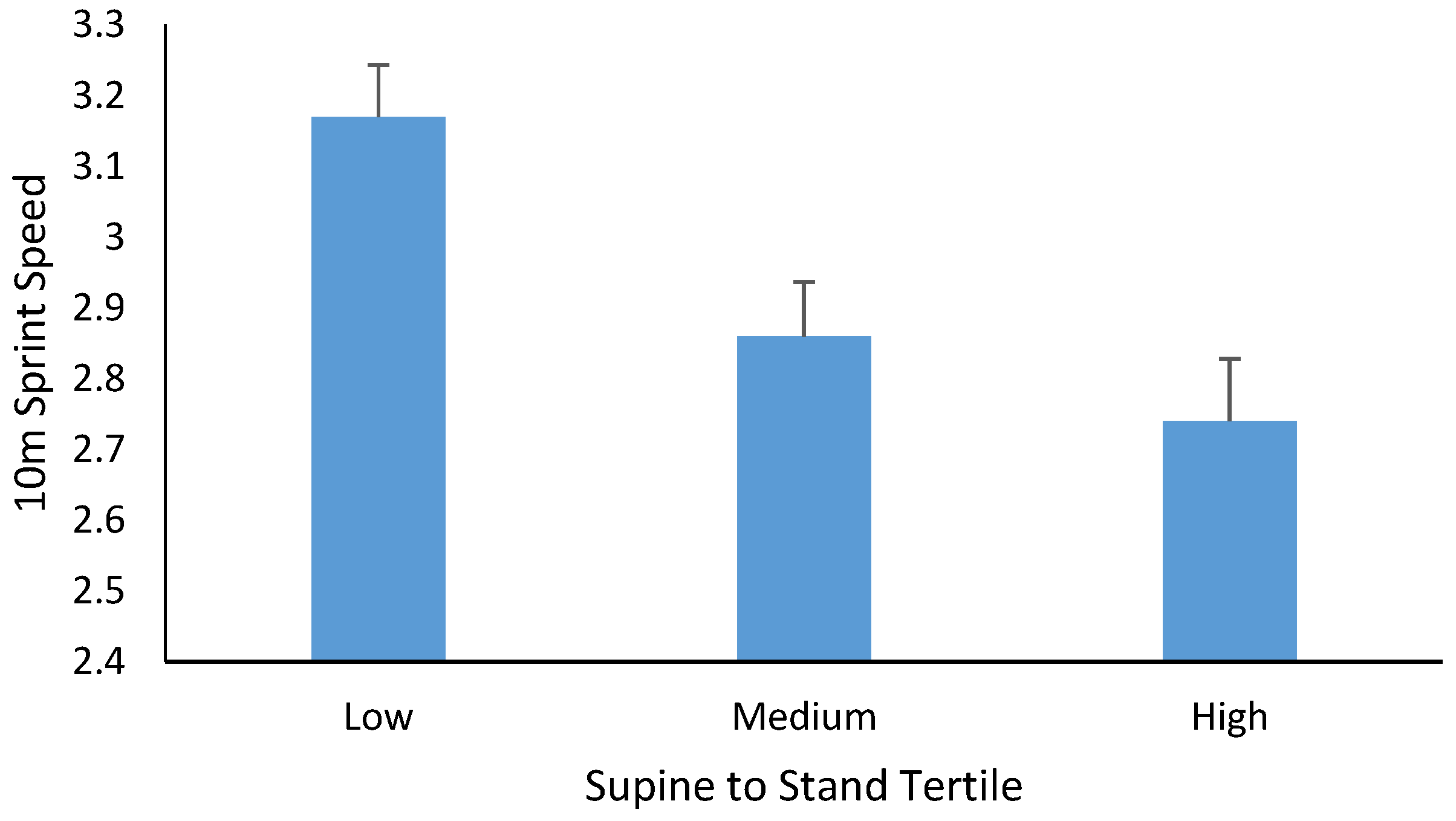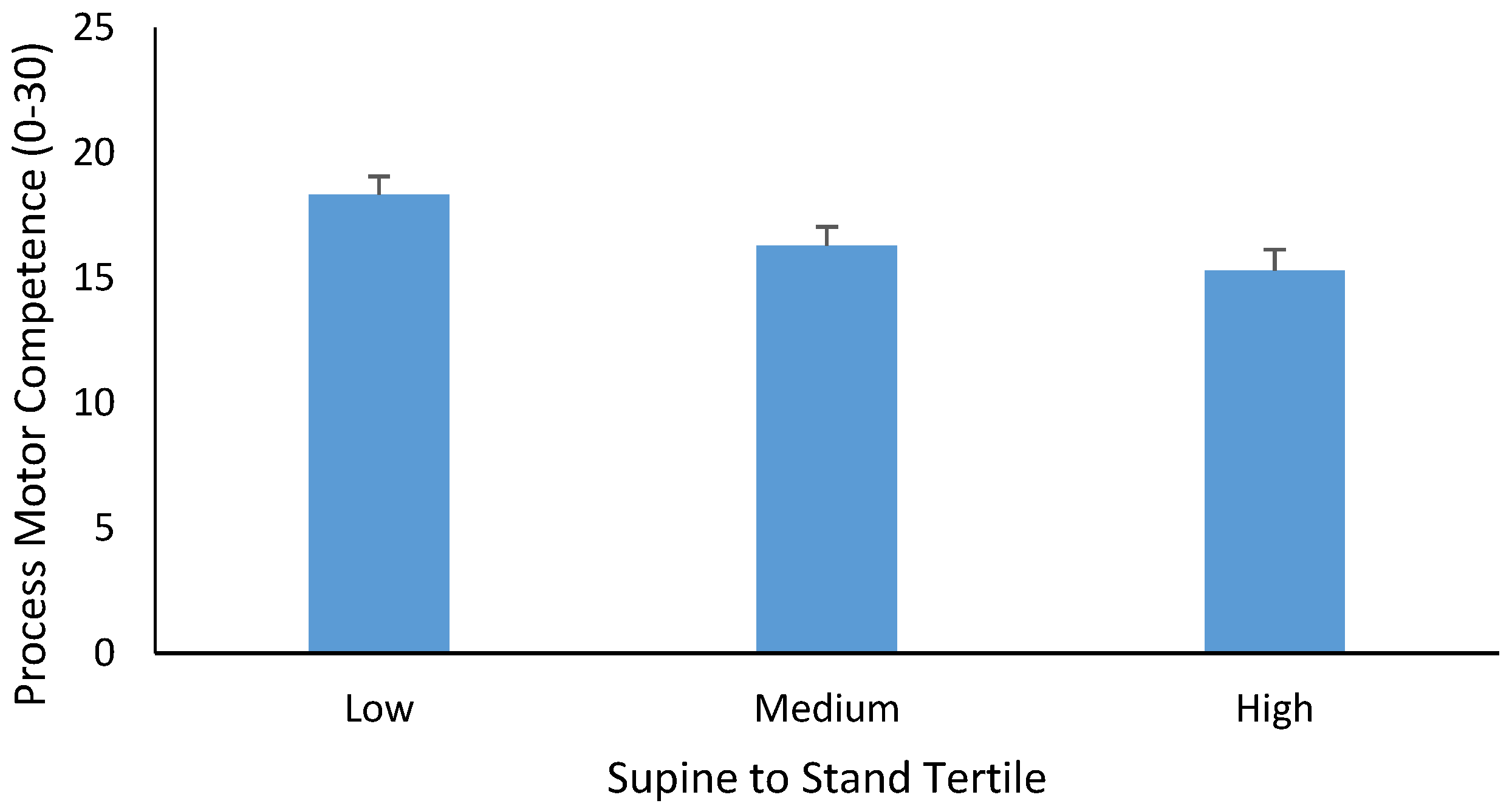The Utility of the Supine-to-Stand Test as a Measure of Functional Motor Competence in Children Aged 5–9 Years
Abstract
:1. Introduction
2. Materials and Methods
2.1. Participants
2.2. Procedures
2.3. Anthropometry
2.4. Process Motor Competence Assessment
2.5. Product Motor Competence Assessment
2.6. Supine to Stand Performance
2.7. Statistical Analysis
3. Results
3.1. The Supine to Stand Process
3.2. The Supine-to-Stand Product
4. Discussion
5. Conclusions
Author Contributions
Conflicts of Interest
References
- Green, L.N.; Williams, K. Differences in developmental movement patterns used by active versus sedentary middle-aged older adults coming from a supine position to erect stance. Phys. Ther. 1992, 72, 560–568. [Google Scholar] [CrossRef] [PubMed]
- Klima, D.W.; Anderson, C.; Samrah, D.; Patel, D.; Chui, K.; Newton, R. Standing from the floor in community dwelling older adults. J. Aging Phys. Act. 2016, 24, 207–213. [Google Scholar] [CrossRef] [PubMed]
- Nesbitt, D.R.; Molina, S.; Cattuzzo, M.T.; Phillips, D.S.; Robinson, L.; Stodden, D.F. Assessment of a Supine-to-Stand (STS) task in early childhood: A measure of functional motor competence. J. Mot. Learn. Devel. 2017. [Google Scholar] [CrossRef]
- Brito, L.B.; de Araujo, D.S.; de Araujo, C.G. Does flexibility influence the ability to sit and rise from the floor? Am. J. Phys. Med. Rehabil. 2013, 92, 241–247. [Google Scholar] [CrossRef] [PubMed]
- Bohannon, R.M.; Lusardi, M.M. Getting up from the floor. Determinants and techniques among healthy older adults. Physiother. Theory Pract. 2004, 20, 233–241. [Google Scholar] [CrossRef]
- Ng, J.; Conaway, M.R.; Rigby, A.S.; Priestman, A.; Baxter, P.S. Methods of standing from supine and percentiles for time to stand and to run 10 meters in young children. J. Pediatr. 2013, 162, 552–556. [Google Scholar] [CrossRef] [PubMed]
- Zettergren, K.K.; Lubeski, J.M.; Viverito, J.M. Effects of a yoga program on postural control, mobility, and gait-speed in community-living older adults: A pilot study. J. Geriatr. Phys. Ther. 2011, 34, 88–94. [Google Scholar] [CrossRef] [PubMed]
- Ulbrich, J.; Raheja, A.; Alexander, N.B. Body positions used by healthy and frail older adults to rise from the floor. J. Am. Geriatr. Soc. 2000, 48, 1626–1632. [Google Scholar] [CrossRef] [PubMed]
- VanSant, A.F. Age Differences in Movement Patterns Used by Children to Rise from a Supine Position to Erect Stance. Phys. Ther. 1988, 68, 1330–1338. [Google Scholar] [CrossRef] [PubMed]
- VanSant, A.F. Rising from a Supine Position to Erect Stance: Description of Adult Movement and a Developmental Hypothesis. Phys. Ther. 1988, 68, 185–192. [Google Scholar] [CrossRef] [PubMed]
- VanSant, A.F. Life-span development in functional tests. Phys. Ther. 1990, 70, 788–798. [Google Scholar] [CrossRef] [PubMed]
- Burton, A.W.; Miller, D.E. Movement Skill Assessment; Human Kinetics: Champaign, IL, USA, 1998. [Google Scholar]
- Ulrich, D.A. Test of Gross Motor Development, 2nd ed.; Pro-ED: Austin, TX, USA, 2000. [Google Scholar]
- Department of Education. National Curriculum in England: PE Programmes of Study; Department of Education: London, UK, 2013. [Google Scholar]
- Field, A. Discovering Statistics Using SPSS; Sage: London, UK, 2013. [Google Scholar]
- Zaykin, D.V.; Zhivotovsky, L.A.; Westfall, P.H.; Weir, B.S. Truncated product method for combining p-values. Genet. Epidemiol. 2002, 22, 170–185. [Google Scholar] [CrossRef] [PubMed]
- Cook, G.; Burton, L.; Hoogenboom, B. Pre-participation screening: The use of fundamental movements as an assessment of function—Part 1. N. Am. J. Sports Phys. Ther. 2006, 1, 62–72. [Google Scholar] [PubMed]
- Logan, S.W.; Barnett, L.M.; Goodway, J.D.; Stodden, D.F. Comparison of performance on process and product oriented assessments of fundamental motor skills across childhood. J. Sports Sci. 2017, 35, 634–641. [Google Scholar] [CrossRef] [PubMed]



| Measure Taken | BMI (kg/m2) | Standing Long Jump Distance (cm) | 10 m Running Speed (s) | Supine to Stand Process (out of 28) | Supine to Stand Time (s) |
|---|---|---|---|---|---|
| Process Motor Competence (0–30) | −0.180 | 0.628 ** | −0.634 ** | 0.457 ** | −0.463 ** |
| BMI (kg/m2) | −0.308 ** | 0.411 ** | −0.408 ** | −0.508 ** | |
| Standing Long Jump Distance (cm) | −0.713 ** | 0.369 ** | −0.414 ** | ||
| 10 m Running Speed (s) | −0.532 ** | 0.539 ** | |||
| STS Process (out of 28) | −0.525 ** |
© 2017 by the authors. Licensee MDPI, Basel, Switzerland. This article is an open access article distributed under the terms and conditions of the Creative Commons Attribution (CC BY) license (http://creativecommons.org/licenses/by/4.0/).
Share and Cite
Duncan, M.J.; Lawson, C.; Walker, L.J.; Stodden, D.; Eyre, E.L.J. The Utility of the Supine-to-Stand Test as a Measure of Functional Motor Competence in Children Aged 5–9 Years. Sports 2017, 5, 67. https://doi.org/10.3390/sports5030067
Duncan MJ, Lawson C, Walker LJ, Stodden D, Eyre ELJ. The Utility of the Supine-to-Stand Test as a Measure of Functional Motor Competence in Children Aged 5–9 Years. Sports. 2017; 5(3):67. https://doi.org/10.3390/sports5030067
Chicago/Turabian StyleDuncan, Michael J., Chelsey Lawson, Leanne Jaye Walker, David Stodden, and Emma L. J. Eyre. 2017. "The Utility of the Supine-to-Stand Test as a Measure of Functional Motor Competence in Children Aged 5–9 Years" Sports 5, no. 3: 67. https://doi.org/10.3390/sports5030067




